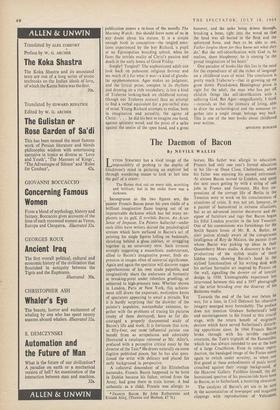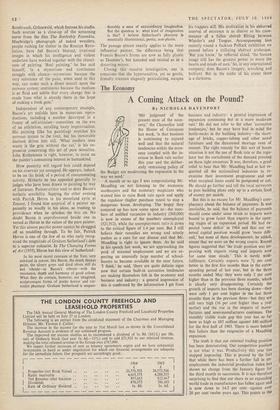The Daemon of Bacon
By NEVILE WALLIS
Incongruous as the two figures are, the painter Francis Bacon poses his own riddle of a brilliant imaginative flame leaping out of an impenetrable darkness which has led many ex- plorers to its gulf. II terribile Bacon, An Acute Sense of Impasse, Un Peintre hallucine—under such titles have writers skirted the psychological stresses which have surfaced in Bacon's act of painting his single figures lolling on bedsteads, shrieking behind a glass cabinet, or struggling together in an unsavoury stew. Such torment strongly suggesting a masochistic undercurrent, allied to Bacon's imaginative power, finds ex- pression in images often of universal significance. Again and again the spectator will discover vague apprehensions of his own made palpable, and imaginatively share the endurance of humanity at breaking-point under relentless gruelling, or subjected to high-pressure tests. Whether shown in London, Paris or New York, this achieve- ment still draws the expectant, motionless knots of spectators appearing to await a miracle. Yet it is hardly surprising that the disorder of the painter's impulsive, noctambular existence, to- gether with the problems of tracing his pictures (many of them destroyed), have so far dis- couraged a properly documented study of Bacon's life and work. It is fortunate that now, at fifty-four, our most 'influential painter can benefit from so scrupuluous and admirably illustrated a catalogue raisonne as Mr. Alley's, prefaced with a perceptive critical essay by the director of the Tate.* He draws naturally on some fugitive published pieces, but he has also ques- tioned the artist with delicacy and placed his early background in perspective.
A collateral descendant of his Elizabethan namesake, Francis Bacon happened to be born in Dublin because his father, retired from the Army, had gone there to train horses. A bad asthmatic as a child, Francis was allergic to
* FRANCIS BACON. By John Rothenstein and Ronald Alley, (Thames and Hudson, £7 7s.) T YTTON STRACHEY has a vivid image of the L./impossibility of probing to the depths of Gladstone's mind in picturing an explorer led through wandering mazes to look at last into the gulf of a crater: The flames shot out on every side, scorching and brilliant; but in the midst there was a darkness. horses. His father was allergic to education. Francis had only one year's formal education in his life—at Dean Close, Cheltenham, where his father was enjoying his second retirement. At sixteen Bacon moved to London, and spent the next years getting by with a string of odd jobs in France and Germany. His first im- pressions of the corrupt life of Berlin in the Twenties were to work on his consciousness of situations of crisis. It was not yet, however, as a painter of humankind in extreme siruations, but as an advanced interior decorator and de- signer of furniture and rugs that Bacon began his fitful London practice in the late Twenties. One of his commissions was furnishings for the Smith Square house of Mr. R. A. Butler, an alert patron already aware of the conspicuous intelligence of Roy de Maistre, the painter from whom Bacon was picking up ideas in their Queensberry Mews studio. A discovery is the re- productions of the stylish studio of these hidden years, showing Bacon's hand in the stylised functionalism of his writing desk with his earliest Surrealist art inspired by Picasso on the wall, signalling • the dernier cri of interior design in 1930. Unimaginable experience has intervened between this and a 1957 photograPh of the artist brooding over the disarray of Battersea studio.
Towards the end of the last war (when he was, for a time, in Civil Defence) his obsessive imagery emerged most formidably. The preface does not mention Graham Sutherland's helP and encouragement to his friend at this crucial stage, with the return benefit of enigmatic devices which have served Sutherland's disturb- ing apparitions since. In 1944 Francis Bacon broke through with his terrible reptilian creatures, the Tate's triptych of the Eumenides, which he has always intended to use at the base of a large Crucifixion. Even in colour repro' duction, the bandaged image of the Furies seems again to twitch under scrutiny, as when one first gazed at these embodiments of panic terror crouched against their orange background, at the Hanover Gallery. Faithless himself, the de' humanised spectres of his passion-tide have been to Bacon, as to Sutherland, a recurring obsession.
The catalysts of Bacon's art are to be seen in the accumulation of newspaper and magazine clippings with reproductions of Velasquel,
Rembrandt, Grilnewald, which festoon his.studio. Such sources as a close-up of the screaming nurse from the film The Battleship Potemkin, Muybridge's photograph of naked wrestlers, people rushing for shelter in the Russian Revo- lution, have fed Bacon's blurred, irrational images in which his intelligence and violent undertow have worked together with the chanci- ness of painting. 'Real painting,' he has said himself, 'is a mysterious and continuous struggle with chance—mysterious because the very substance of the paint, when used in this way, can make such a direct assault upon the nervous system; continuous because the medium is so fluid and subtle that every change that is made loses what is already there in the hope of making a fresh gain.'
Independent of any contemporary example, Bacon's art unfolds here in numerous repro- ductions, including a number destroyed in a frenzy of self-criticism—sometimes on the eve of an exhibition, entailing hasty improvisation. His painting (like his gambling) stretches his nervous system to the limit, but his inexorable daemon drives him still. 'What modern man • wants is the grin without the cat,' is his ex- pression concerning this art of pure sensation. John Rothenstein is right, however, to insist on the painter's consuming interest in humankind.
How posterity will regard him could depend on his reservoir yet untapped. He appears, indeed, to be on the brink of a period of consummating activity. Hitherto he has appealed generally to judges who have been drawn to painting by way of literature. Painter-critics tend to deny Bacon's esthetic sensibility. Supping the other evening with Patrick Heron in his moorland eyrie at Zennor, I found him sceptical of a painter ap- parently so woolly in his ideas, so trusting to providence when be splashes the bits on. No doubt Bacon is unprofessional beside one as versed as Heron in the values of the pure painter. Yet this almost psychic power cannot be shrugged off as muddling through. To be fair, Patrick Heron is one of the few of us who early recog- nised the magnitude of Graham Sutherland's debt to a superior colourist. In The Changing Forms of Art (1955), Heron has this view of Sutherland: In his most recent canvases at the Tate, very subdued in colour, like Bacon, the much thicker paint, the silvery greys and dead olives still do not vibrate—as Bacon's vibrate—with the resonance, depth and harmony of good colour. What they do contain, however, are imagined, sculpturesque forms of poetic horror and sur- realist phantasy. Graham Sutherland is unques- tionably a man of extraordinary imagination. But the question is : what kind of imagination is this? I believe Sutherland's phantasy is essentially illustrational, poetic, non-plastic.
The passage almost exactly applies to the more influential painter, the difference being that Francis Bacon's forms are now as fully plastic as Daumier's, but kneaded and twisted as in- a distorting mirror.
Closing this massive investigation, one is conscious that the hypersensitive, yet so gentle, friendly creature elegantly gesticulating, escapes his trappers still.. His Motivation in his abhorred interval of existence is as elusive as his coun- tenance of a fallen cherub flitting between Wheeler's and Tangier. Accompanying him recently round a Jackson Pollock exhibition we paused before a titillating abstract arabesque. 'But you know,' he reflected aloud, 'the human image still has the greatest power to move the hearts and minds of men.' So, in any international company, does Bacon's imagery, scorching and brilliant. But in the midst of his crater there is a darkness.











































 Previous page
Previous page